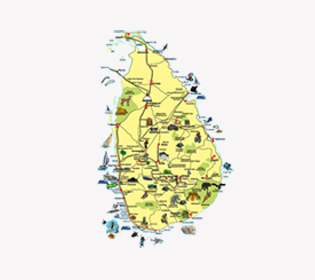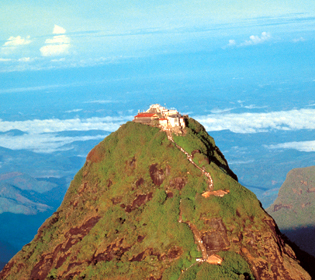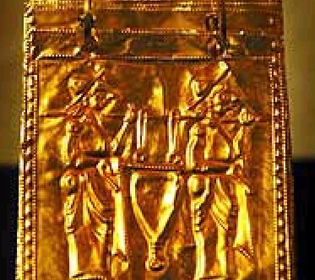
The first capital of Sri Lanka – and remaining so for 1,400 years – Anuradhapura was abandoned and swallowed by the dry-zone jungle two centuries after Vijayabahu I had retaken the country and retained the Cholas capital at Polonnaruwa in the 11th Century.
The only thing that has managed to live – literally – throughout the centuries, carefully attended by guardians all this time, is the sacred Bo Tree, the Sri Maha Bodhi, grown from a sampling of the Bodhi tree under which the Buddha attained enlightenment. The original Bodhi tree has since died, but the Sri Maha Bodhi survives and has been worshipped for 23 centuries, making it the oldest tree in the world.
The significance of this tree attests to the widespread influence of Buddhism, of which the surviving shrines of the ancient city provide more visible evidence. These dome-shaped monuments of worship are known as dagobas or stupas, and notable ones include the Ruwanweli Seya, Thuparamaya and Jetavanarama and Abhayagiri Dagoba.
Monks resided in the Brazen Palace (Loha Prasada), which was first built by King Dutugemunu in the 2nd Century B.C. and which, having suffered two fires, underwent numerous changes at the hands of successive rulers. You’ll have to imagine what this once-magnificent 9-storey high residence must have looked like because all you will see now is a massive space filled with 1,600 pillars in a 40-by-40 grid. Dugutugemunu’s successor Sadhatissa rebuilt a 7-storey building, which was destroyed by the Cholas in the 11th Century, and later restored in the 12th Century by Parakramabahu I, a palace of which only the pillars have survived to the present day.
Other interesting historical sites to visit include the Samadhi Buddha, the work of an anonymous master-sculptor depicting Buddha in deep meditation (an image, in the form of a photograph, which former Indian Prime Minister Jawaharlal Nehru sought inspiration from while serving a prison sentence); the Awkana, a gigantic granite Buddha statue about 32 miles southeast of Anuradhapura; and Mihintale, the sacred site at which Buddhism was first introduced to Sri Lanka in the year 247 B.C.
Otherwise known as the "Great Stupa", Ruwanweli Seya was built under the order of King Dutugemunu, who lived long enough to see through its completion in 144 B.C. - on his deathbed.
The first dagoba built in Sri Lanka; Thuparama is believed to enshrine the right collarbone of the Buddha, which Emperor Asoka dispatched in acknowledgment and appreciation of the city’s conversion to Buddhism. Restoration over the centuries has altered the original design.
The largest and tallest brick monument in the world, and only shorter than two Egyptian pyramids, this mighty dagoba was originally 400 feet high (500 feet including the crystal finial) and 370 feet in diameter at its base. Erected in the late 3rd Century A.D. by King Mahasena, it used to house gold plates containing Sanskrit text of a Mahayana sutra. The Jetavanarama has been declared a UNESCO World Heritage site.
Created by King Vattagamani Abhaya in the 1st Century B.C., this 75-meter high dagoba was originally the centerpiece of a monastic complex accommodating 5,000 monks. The Abhayagiri complex had to honor of being the first place in Sri Lanka to house the sacred "Tooth Relic".

As early as the 7th Century, when Anuradhapura was still the capital, Sri Lankan kings had made Polonnaruwa their country retreat. With the Cholas’ conquest of Anuradhapura in the 11th Century, Polonnaruwa succeeded it as the capital and remained so for the next 200 years - even when Vijayabahu I eventually defeated the South Indian invaders.
The relatively short history of this capital makes it easy for you to explore all the ruins and if you are inclined towards a hard day of walking under a sweltering sun, you could even discover the city on foot. If not, there is always ready transport, with a guide at your ear.
Traveling north from Giritale with the eastern bank of the Parakrama Samudra on your left, you'll first arrive at the Potgul Vehera, a library with splendid acoustics (for performances perhaps) and "The Sage", possibly the statue of King Parakramabahu I, though the subject of its identity has been a matter of some dispute.
Further up is the Royal Citadel of Parakramabahu, of which the audience hall is particularly interesting, with the stone carvings on the base of the pavilion depicting elephants, each in a different position.
Just north of the Royal Palace, you will come to the Quadrangle, where you might want to spend some more time and take a tour around the twelve great structures.
More magnificent structures are on your way as you move even further north, such as the Rankot Vehera ("Golden Pinnacle"), the largest dagoba in Polonnaruwa built by King Nissanka Malla.
Not to be missed is the Gal Vihara, with four larger-than-life statues of the Buddha in various positions - including a rare cross-armed standing pose - all carved from a single wall, with intricate attention to detail.
If you still have energy left to go the distance, you will be rewarded with more wonderful sights including the late 12th Century Lotus Bath, with steps descending in concentric rings of eight-petal lotus flowers.
If you travel by car, you’d probably be able to complete all that in four hours. That’s a whole millennium of Polonnaruwa history in half a day.

About 12 miles from Sigiriya you’ll come to the Raja Maha Vihara, otherwise known as the Dambulla Cave Temple or Golden Temple. This is actually a series of five temples that finds its origin in the Anuradhapura period (1st Century B.C.), even though the art works that have survived to this day are mostly representative of the Kandyan period (18th Century) due to restoration efforts.
These caves used to be places of refuge and have been embellished by several kings throughout Sinhalese history. Be awed by the 157 statues of Buddha and royalty, as well as intricate wall and ceiling frescoes of both religious and secular nature.
Look out especially for the ceiling paintings in the fourth cave, which follow the folds of the rock so closely that they have been mistaken for cloth paintings stuck onto the ceiling.

Desperation can also drive a man to greatness. It must have been a mixture of fear and guilt for having his own father slain and stealing the throne from right under his half brother's nose that motivated King Kasyapa to erect this magnificent fortress – 'Palace in the Sky' – in the 5th Century A.D.
The rock rises out of nowhere, towering 600 feet above you. From the base you can't see the palace, which means you'll have to climb the equivalent of 75 floors up. A fairly healthy person would need about two hours to get up and down, but once you're up there, you'll find that just being on top looking down at the vast forest below is well worth the climb.
Halfway up, you'll see the Sigiriya Damsels – frescoes depicting nearly naked nymphets believed to be Kasyapa's concubines. Out of the 500 or so original paintings, only 26 have survived mutilation by monks who later occupied the fortress. Then there's the three-meter high Mirror Wall where visitors to the fortress, more than a thousand years ago, penned their thoughts on the Sigiriya Damsels.
Eventually you get to a flat piece of land known as the Lion's Terrace, where a further flight of steps leads you through what used to be the lion's mouth, into the throat. That's the only way in. Sigiriya means 'Lion Rock', and now we can see why.
Once you're at the summit, first congratulate yourself for having made it. Then look across into the jungle and see if you can spot a few elephants, probably ant-sized from your vantage point. And finally, marvel at the buildings, of which the Royal Summer House is particularly noteworthy. Here you'll find everything carved out of living rock, from thrones to rock-and-water gardens to bathing pools.
To think that all this came about, because one man killed his father.



